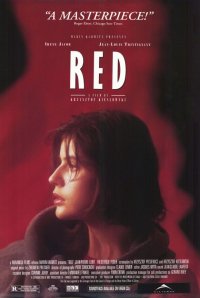Three Colors: Red (Kieslowski, 1994)
I entered Krzysztof Kieslowski's final entry in his Three Colors Trilogy, Three Colors: Red, with a great deal of uncertainty tinged with a splash of hopefulness. I had little frame of reference for this film, knowing little about the actual plot that would be explored and having never seen another film from the Polish director, but the reputation these films have built up since their release in the early 1990's is astounding. However, outside of the reputation I did not know the plot of this film or its exact connections to the previous two films in the trilogy. So after sitting down to confront this film would it have been better to build context with the other two films or will I have to already begin revising my Top 97?Focusing on a few days in the life of model Valentine (Irene Jacob), Kieslowski explores a fairly basic idea of coincidence and fate in an individual's life, but to say that the film is only about this concept seems dismissive of the breadth and intricacies that the director has crafted. Valentine encounters a retired judge, Joseph (Jean-Louis Trintignant), who spends his days eavesdropping on local phone calls. Trintignant brings a mysterious quality to the judge character though that does not make him a condemnable figure; instead, the man acts as either a sage with specific insight to the world around him and Valentine or as a mirror image of a judge to be, Auguste (Jean-Pierre Lorit). Auguste exists earlier in the film as a third party who seems fairly unconnected to the plot, but as the movie progresses we see his importance grow.
Kieslowski establishes and reinforces this importance through masterful camerawork that relies on the doubling of shots that directly and indirectly asks the viewer to begin connecting the characters and places to one another. Throughout the film we see Auguste and Valentine share the screen, but they always pass each other or come in and out of frame only seconds apart, not directly establishing a connection but giving the viewer a feeling that the two are propelling to a common meeting point. What I find so genius about the construction of the film is not in how on the nose some of the mirroring of shots is, but rather on how well it works with the overall feel that Kieslowski establishes through the uncertainty in the existence of Joseph. Early on I felt a sense of tension between the deliberate construction of the film, the abundant use of red and the far too perfect coincidences (the cafe named Joseph, the book falling in the road, and a few other occurrences), and the natural way that individuals develop connection and romance in the real world; however, the possibility that Joseph has an insight to Valentine's life and is helping propel her toward a meeting with Auguste extends the idea of coincidence to have it clash with the idea of fate.
Initially I did not find Red to be an overly compelling watch, but even just a day later the film has settled incredibly well. The film is not without its share of flaws, the actual film does take a while to get started and because the ideas are so well developed and reinforced through the camerawork the actual plot is mostly mundane. The film establishes a tone incredibly well, so well in fact that I was nearly prepared for the film to simply stop when the mood had been sufficiently built. But the way the film elevates itself from that stopping point to take on so many more concepts is simply staggering and has me interested to check out the rest of Kieslowski's filmography.
Netflix Rating: ****/*****
Rich
Comments are welcome and, for anyone with a literary mind, I encourage checking out my poetry blogfilled with all original works for your reading pleasure. Or if video games are more your thing, I have a blog dedicated to all gaming news, reviews, and opinions.
Also, I am on the old Twitter thing so I guess you can follow me at twitter.com/FLYmeatwad.
© 2011 Richard James Thorne
Also, I am on the old Twitter thing so I guess you can follow me at twitter.com/FLYmeatwad.
© 2011 Richard James Thorne

Interesting. I would have suggested seeing the first two films before, especially because Red's ending is a wrap up for the entire trilogy.
ReplyDeleteHaving seen it several times, I could see how you might think it takes a while to get started, but I always find myself engrossed throughout the entire experience.
I like how you express the idea of coincidence and fate, something I think weaves its way through most of Kieslowski's work. If you're interested in that theme more, watch Blind Chance, which is his most head-on exploration of the idea.
I appreciate your discussion of fate/coincidence, too, and I'm very curious to see what you think of some of his other films, especially as they play with that idea, too. It runs throughout much of the Decalogue and through Veronique as well. (And when you see the first two of the colors trilogy, the sense of it in Red, viz. in the ending, will be further enforced!).
ReplyDeleteIndeed. I'm not even sure why I watched this one first - though I think it may have been for the MDC - but I should probably bump Veronique higher in my Netflix queue because thinking back on when I watched RED I still remember a good deal about what I enjoyed.
ReplyDeleteAlso, since I do not own any of them I hope to pick up that Criterion trilogy set when it comes out.
Thanks for the recommendations!